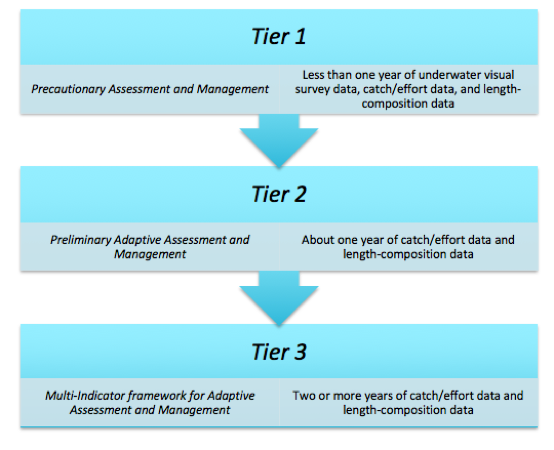1 Step 1 – Determine Assessment and Management Tier
What information do I have, and how can I use it?

Figure 1.1: Step 1
In the first step of this toolkit, you will determine the assessment and management “tier” of your fishery based on the types of information and data that are available (Figure 1.2). Depending on the data that are available, you will have different options for fisheries management controls and assessment methods. The tier you determine during this step will be used throughout the remaining steps of the toolkit. If your site follows this plan, you will automatically begin collecting the necessary data to eventually move to Tier 3.

Figure 1.2: AFAM Toolkit tier flowchart
1.1 Step 1a – Fill out your Data Inventory
Fill out your inventory of available data.
1.2 Step 1b – Using your Data Inventory, Determine Assessment and Management Tier
Use the following questions to determine which assessment tier is most appropriate for your site:
Do you have two or more years of catch/effort data (from individual catch reporting and/or boat intercept or landing site survey)? Do you also have two or more years of fishery-dependent length-composition survey data?
Yes – Use the Tier 3 category and continue collecting data.
No - Continue on to question two.
Do you have at least one year of catch/effort data (from individual catch reporting and/or boat intercept or landing site survey) and fishery-dependent length-composition survey data?
Yes - Use the Tier 2 category and continue collecting data.
No –Use the Tier 1 category.
The three assessment and management categories are described in more detail below. We will discuss the specifics of fisheries management controls and performance indicators in the following steps. As you collect more and more data over time, your site will be able to move from one tier to the next.
Tier 1 – Precautionary Assessment and Management (for new sites with less than one year of data)
Under most scenarios, Tier 1 describes a new site, with no pre-existing standardized data collection and monitoring program in place. The only information available will likely come from qualitative information and local ecological knowledge. Even though little to no data is present, managers can still perform a basic fisheries assessment and select precautionary fisheries management controls (FMCs) until more data is collected. The goal of Tier 1 is to implement precautionary assessment and management measures that can benefit a fishery of any status until more data is collected for the fishery. When we are uncertain about the status and dynamics of a resource, it is prudent to interact with the resource in a way that minimizes the risks of something ‘bad’ happening. One of the most effective precautionary management techniques is to limit the use of destructive fishing gears and/or practices. Another common precautionary management technique is to protect spawning aggregations through the implementation of a seasonal closure.
Tier 2 – Preliminary Adaptive Assessment and Management (for sites with one year of data)
Tier 2 sites will have roughly one year of data that come from some combination of catch reporting, boat intercept or landing site survey, or fishery-dependent length-composition surveys. The goal of Tier 2 is to provide the preliminary assessment and management methods for a fishery, while continuing to collect more data. A suite of FMCs can also be used in combination to meet multiple objectives where appropriate.
Tier 3 – Multi-Indicator framework for Adaptive Assessment and Management (for sites with more than one year of data)
Tier 3 sites will have a time series of data available that can be used to examine trends in multiple performance indicators and implement FMCs such based on an improved scientific understanding of stock status. Under Tier 3, each species should have several performance indicators, which should ideally come from different data streams, in order to gain a more complete understanding of the fishery and reduce uncertainty. Multiple performance indicators from multiple data streams are used to gain a more complete understanding of the fishery and to reduce the implications of uncertainty, bias, or error associated with any single indicator or data stream. Furthermore, corroboration between indicators can allow for a confident interpretation of fishery performance. Additionally, with multiple years of data, limits and targets can be estimated from running averages or the average of the past few years. Running averages take into account variability in the environment and the fishery. Ecosystem-level indicators should be included if the sustainable provision of non-fishery ecosystem services is a management goal.